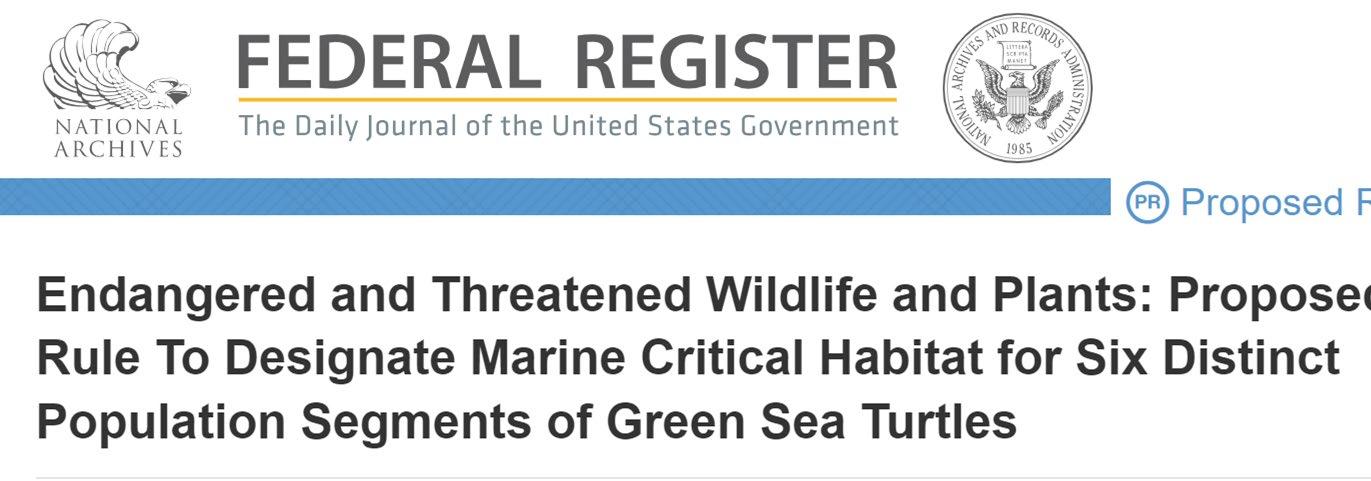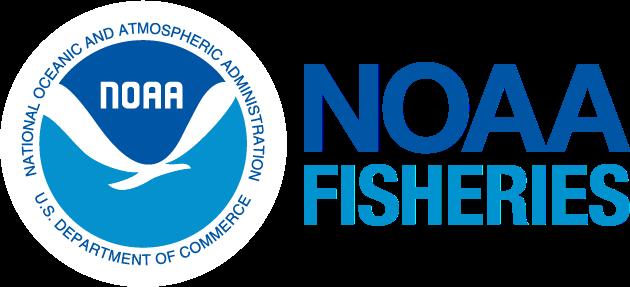A Synopsis of 2 New Endangered Species Act Critical Habitat Rules







● What Critical Habitat Is
● Green Sea Turtle Critical Habitat Proposed Rule
● Caribbean Coral Critical Habitat Final Rule
● Update on other rulemaking

● Critical habitat is defined as:
○ Specific areas within the geographical area occupied by the species at the time of listing that contain physical or biological features essential to conservation of the species and that may require special management considerations or protection
● We are required to designate critical habitat based on the best available scientific data. We must also consider the economic, national security, and other relevant impacts of specifying a particular area as critical habitat.
● The ESA requires that we designate critical habitat, to the maximum extent prudent and determinable, when a species is listed under the ESA.
For More Information about ESA Critical Habitat:
https://www.fisheries.noaa.gov/national/endangered-species-conservation/critical-habitat

● April 6, 2016: NMFS and USFWS published a final rule to list 11 green turtle distinct population segments (DPSs) as threatened or endangered (81 FR 20057). Replaced the original listing for the species; concluded that previously designated critical habitat remained in effect for the North Atlantic DPS.
● January 8, 2020: Center for Biological Diversity, Sea Turtle Oversight Protection, and Turtle Island Restoration Network filed a complaint, alleging failure to designate critical habitat by the statutory deadline.
● August 21, 2020: parties entered into a settlement agreement stipulating that NMFS and USFWS submit proposed determinations concerning the designation of critical habitat to the Federal Register on or before June 30, 2023.
● July 19, 2023 : NMFS and USFWS published proposed rules to designate critical habitat (88 FR 46572 and 88 FR 46376)

1. Nesting females to/from beach
1. Hatchling dispersal
1. Surface-pelagic foraging/resting
1. Nearshore foraging/resting

1. Breeding migration
1. Mating, internesting

Essential Features LIfe-Stage
Reproductive Adult and hatchling (swim frenzy)
Migratory Adult
Post-hatchling and juvenile
Foraging/Resting
Juvenile, sub-adult, and adult
Habitat
Nearshore
Nearshore
Surface-pelagic (oceanic)
Nearshore (benthic)

Reproductive (not East Pacific DPS): From the mean high water line to 20 m depth, sufficiently dark and unobstructed nearshore waters adjacent to nesting beaches designated as critical habitat by USFWS, to allow for the transit, mating, and internesting of reproductive individuals and the transit of post-hatchlings.
Migratory (North Atlantic and East Pacific DPSs only): From the mean high water line to 20 m depth (North Atlantic DPS) or 10 km offshore (East Pacific DPS), sufficiently unobstructed waters that allow for unrestricted transit of reproductive individuals between benthic foraging/resting and reproductive areas.

Benthic foraging/resting: From the mean high water line to 20 m depth, underwater refugia and food resources (i.e., seagrasses, macroalgae, and/or invertebrates) of sufficient condition, distribution, diversity, abundance, and density necessary to support survival, development, growth, and/or reproduction.
Surface-pelagic foraging/resting (“Sargassum;” North Atlantic DPS only): Convergence zones, frontal zones, surface-water downwelling areas, the margins of major boundary currents, and other areas that result in concentrated components of the Sargassum-dominated drift community, as well as the currents which carry turtles to Sargassum-dominated drift communities, which provide sufficient food resources and refugia to support the survival, growth, and development of post-hatchlings and surface-pelagic juveniles, and which are located in sufficient water depth (at least 10 m) to ensure offshore transport via ocean currents to areas which meet forage and refugia requirements.






● One virtual public hearings on North Atlantic and South Atlantic DPSs on August 29, 2023, from 6 p.m. to 8 p.m., Eastern time
○ Registration required:
■ https://www.fisheries.noaa.gov/event/public-hearings-proposedcritical-habitat-green-sea-turtles-under-endangered-species-act

● Submit public comments by October 17, 2023.
● We will review and incorporate public comments and submit a final rule to the Federal Register by July 19, 2024.
● For more information to inform commenting, visit:
https://www.fisheries.noaa.gov/action/proposed-rule-designate-criticalhabitat-green-sea-turtles
● Distribution and habitat use of green turtles; relative conservation value of specific areas containing the essential features, information on potential benefits of designating any particular area as critical habitat, and the boundaries of specific areas and proposed critical habitat units.
● Information on types of Federal actions that may trigger an ESA section 7 consultation and possible modifications that may be required of those activities; current or planned activities in the areas proposed as critical habitat, including both Federal and non-Federal activities, that may be impacted by the proposed critical habitat designation.

● Any foreseeable economic, national security, Tribal, or other relevant impact resulting from the proposed designations.
● Whether any data used in the economic analysis needs to be updated; additional costs arising specifically from the designation not identified in the Draft Economic Analysis or improved costs estimates for activities that are included in the Draft Economic Analysis
● Additional information regarding impacts on small businesses that were not identified in the Draft Economic Analysis or the initial regulatory flexibility analysis.
● Designation does not directly affect citizens engaged in recreational activities, such as recreational boating and fishing, or limit their access to the critical habitat area.
● Designation does not create any new regulations or restrictions on fisheries. Only federal agencies are directly affected by a critical habitat designation; non-federal entities may be affected if their activities involve federal funding, permitting, or authorization.

● Federal agencies already consult with NOAA Fisheries on actions that may affect listed green sea turtle DPS (and on the 5 Caribbean coral species for which critical habitat was just finalized).)
● Consultation on designated critical habitat evaluates whether a proposed federal action would adversely affect critical habitat by considering if it occurs in critical habitat and if so if any of the essential features would be affected and how.
● Process which involves informal discussions between a Federal agency and the Service under section 7(a)(4) of the Act regarding the impact of an action on proposed species or proposed critical habitat and recommendations to minimize or avoid the adverse effects.”
● Section 7(a)(4) of the Act requires Federal agencies to confer with the Secretary on any action that is likely to jeopardize the continued existence of proposed species or result in the destruction or adverse modification of proposed critical habitat.
● Federal action agencies may request a conference on any proposed action that may affect proposed species or proposed critical habitat





● Boulder star coral (Orbicella franksi)


Lobed star coral (O. annularis) ● Mountainous star coral (O. faveolata),
Pillar coral (Dendrogyra cylindrus)
Rough cactus coral (Mycetophyllia ferox)

Sites that support the normal function of all life stages of the corals, including reproduction, recruitment, and maturation. These sites are natural, consolidated hard substrate or dead coral skeleton, which is free of algae and sediment at the appropriate scale at the point of larval settlement or fragment reattachment, and the associated water column. Several attributes of these sites determine the quality of the area and influence the value of the associated feature to the conservation of the species:
1. Substrate with the presence of crevices and holes that provide cryptic habitat, the presence of microbial biofilms, or presence of crustose coralline algae;
2. Reefscape with no more than a thin veneer of sediment and low occupancy by fleshy and turf macroalgae;
3. Marine water with levels of temperature, aragonite saturation, nutrients, and water clarity that have been observed to support any demographic function; and
4. Marine water with levels of anthropogenically-introduced (from humans) chemical contaminants that do not preclude or inhibit any demographic function.

● 5 Species
● 1 unit for each species based on depth distribution in each geographic area it occurs
● 28 total units
● Within each geographic area, units are mostly overlapping
● 1 excluded area - Navy South Florida Ocean Measuring Facility near Dania Beach, FL







No changes
Acropora CH Area: 0 sq km
Proposed Maximum Area: 11 sq km
Final Maximum Area: 11 sq km
Delta: 0 sq km


